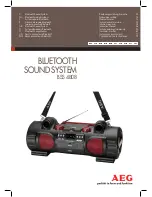
MITSUBISHI ELECTRONICS AMERICA, INC.
ST200 Series Technical Support Manual
28
January 2000
other non-metallic materials. Foliage can also potentially degrade signal quality. Users
should strive for a completely clear line-of-site for best performance.
♦
All terminals can preserve satellite connection despite signal (line of sight) blockages of up
to 15 seconds. Therefore, Mitsubishi MTs may not have to re-acquire the satellite or re-dial
the called party for temporary obstructions. For example, the ST211 land mobile
configuration can retain connections while driving under an overpass.
♦
The ST211 land mobile terminal requires roughly 10 seconds of static operation or motion
along a straight path at start-up, for rapid satellite acquisition and tracking. Turns and
maneuvers prior to acquisition skew the baseline BSU conditions, degrading performance.
♦
The RSSI, displayed on the handset, indicates received satellite signal strength on a numeric
scale of 0 through 80. The initial setup screen displays the RSSI and users can continuously
view signal strength using handset
function 84
. Mitsubishi MTs also display a graphic bar
representation of signal strength at all times, in the upper right hand corner of the handset
LCD. The table below shows the relationship between numeric and graphic RSSI values.
Numeric RSSI
Graphic RSSI (Number of Signal Bars)
0
0
1-8
1
9-18
2
19-28
3
29-38
4
39-48
5
49-80
6
♦
The RSSI is a relative measure of received signal strength for a particular MT, based on
automatic gain control settings. RSSI values vary among MTs, even for the same received
signal strength. Dealers should not assume that a lower RSSI value for a particular MT,
compared with others, definitely indicates a problem (unless other problems are also present).
RSSI values in the 35-50 range are considered normal. It is unlikely that you will measure an
RSSI value of above 50 on your MT.
♦
The RSSI displays the received signal strength of the pilot channel during acquisition, the
GC-S channel after acquisition, and FES-C channel during and active call. The relative level
of these three channels differs with location, time, and network status.
♦
All MT configurations include a beam cross-over selection mode (
function 96
). Users can
select a threshold for the frequency with which their MT searches for another satellite beam
when a channel drops. These thresholds are
very slow
,
slow
,
normal
, and
fast
. Therefore,
users of the ST211 who typically travel across beam intersections would probably want to
select
fast
. In this case satellite acquisition times would improve for crossing between
satellite beams. Users who typically operate within a single satellite beam would probably
want to select
very slow
, resulting in a more efficient satellite acquisition. The ST221M has
the same feature within its software, but is not relevant since the unit will be installed in a
fixed location.
















































